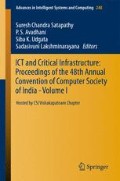Abstract
A new feature selection methodology on the basis of features’ combined class separability power, using the framework of Axiomatic Fuzzy Set (AFS) theory has been proposed here. The AFS theory provides the rules for logic operations needed to interpret the combinations of features from the fuzzy feature set. Based on these combinational rules, class separability power of the combined features is determined and subsequently the most powerful subset of the feature set is selected. The performance of this methodology is evaluated upon for recognition of handwritten numerals of five popular Indic scripts viz. Bangla, Devanagari, Roman, Telugu and Arabic with SVM based classifier using gradient based directional feature set and quad-tree based longest-run feature set separately and compared with six widely used feature selection techniques. From the experimental results, it has been found that the methodology provides higher recognition accuracies with lesser or equal numbers of features selected for each dataset.
Access this chapter
Tax calculation will be finalised at checkout
Purchases are for personal use only
Preview
Unable to display preview. Download preview PDF.
References
Tsamardinos, I., Aliferis, C.F.: Towards principled feature selection: Relevancy, filters and wrappers. In: Proceedings of the Ninth International Workshop on Artificial Intelligence and Statistics. Morgan Kaufmann Publishers, Key West (2003)
Hall, M.A., Smith, L.A.: Feature selection for machine learning: comparing a correlation-based filter approach to the wrapper. In: Proceedings of the Twelfth International Florida Artificial Intelligence Research Society Conference, p. 239. AAAI Press (1999)
Roy, A., Das, N., Basu, S., Sarkar, R., Kundu, M., Nasipuri, M.: Region selection in handwritten character recognition using Artificial Bee Colony Optimization. In: EAIT, pp. 189–192 (2012)
Mitra, P., Murthy, C., Pal, S.K.: Unsupervised feature selection using feature similarity. IEEE Transactions on Pattern Analysis and Machine Intelligence 24, 301–312 (2002)
Hall, M.A.: Correlation-based feature selection for machine learning. The University of Waikato (1999)
Peng, H., Long, F., Ding, C.: Feature selection based on mutual information criteria of max-dependency, max-relevance, and min-redundancy. IEEE Transactions on Pattern Analysis and Machine Intelligence 27, 1226–1238 (2005)
Lee, H.-M., Chen, C.-M., Chen, J.-M., Jou, Y.-L.: An efficient fuzzy classifier with feature selection based on fuzzy entropy. Trans. Sys. Man Cyber. Part B 31, 426–432 (2001)
Luukka, P.: Feature selection using fuzzy entropy measures with similarity classifier. Expert Systems with Applications 38, 4600–4607 (2011)
Guyon, I., Elisseeff, A.: An introduction to variable and feature selection. The Journal of Machine Learning Research 3, 1157–1182 (2003)
Rezaee, M.R., Goedhart, B., Lelieveldt, B., Reiber, J.: Fuzzy feature selection. Pattern Recognition 32, 2011–2019 (1999)
Li, Y., Wu, Z.F.: Fuzzy feature selection based on min–max learning rule and extension matrix. Pattern Recognition 41, 217–226 (2008)
Liu, X., Pedrycz, W.: Axiomatic Fuzzy Set Theory and Its Applications. STUDFUZZ, vol. 244. Springer, Heidelberg (2009)
Xiaodong, L.: The fuzzy theory based on AFS algebras and AFS structure. Journal of Mathematical Analysis and Applications 217, 459–478 (1998)
Wang, X., Liu, X., Pedrycz, W., Zhu, X., Hu, G.: Mining axiomatic fuzzy set association rules for classification problems. European Journal of Operational Research 218, 202–210 (2012)
Ren, Y., Liu, X., Cao, J.: A parsimony fuzzy rule-based classifier using axiomatic fuzzy set theory and support vector machines. Information Sciences 181, 5180–5193 (2011)
Tao, L., Chen, Y., Liu, X., Wang, X.: An integrated multiple criteria decision making model applying axiomatic fuzzy set theory. Applied Mathematical Modelling (2011)
Roy, A., Mazumder, N., Das, N., Sarkar, R., Basu, S., Nasipuri, M.: A new quad tree based feature set for recognition of handwritten Bangla numerals. In: 2012 IEEE International Conference on Engineering Education: Innovative Practices and Future Trends (AICERA), pp. 1–6 (2012)
Das, N., Reddy, J.M., Sarkar, R., Basu, S., Kundu, M., Nasipuri, M., Basu, D.K.: A statistical-topological feature combination for recognition of handwritten numerals. Appl. Soft Comput. 12, 2486–2495 (2012)
Roy, A., Das, N., Sarkar, R., Basu, S., Kundu, M., Nasipuri, M.: A Comparative Study of Feature Ranking Methods in Recognition of Handwritten Numerals. In: IEEE International Conference on Signal Processing, Computing and Control (ISPCC), September 26-28 (2013)
Hall, M., Frank, E., Holmes, G., Pfahringer, B., Reutemann, P., Witten, I.H.: The WEKA data mining software: an update. ACM SIGKDD Explorations Newsletter 11, 10–18 (2009)
Author information
Authors and Affiliations
Corresponding author
Editor information
Editors and Affiliations
Rights and permissions
Copyright information
© 2014 Springer International Publishing Switzerland
About this paper
Cite this paper
Roy, A., Das, N., Sarkar, R., Basu, S., Kundu, M., Nasipuri, M. (2014). An Axiomatic Fuzzy Set Theory Based Feature Selection Methodology for Handwritten Numeral Recognition. In: Satapathy, S., Avadhani, P., Udgata, S., Lakshminarayana, S. (eds) ICT and Critical Infrastructure: Proceedings of the 48th Annual Convention of Computer Society of India- Vol I. Advances in Intelligent Systems and Computing, vol 248. Springer, Cham. https://doi.org/10.1007/978-3-319-03107-1_16
Download citation
DOI: https://doi.org/10.1007/978-3-319-03107-1_16
Publisher Name: Springer, Cham
Print ISBN: 978-3-319-03106-4
Online ISBN: 978-3-319-03107-1
eBook Packages: EngineeringEngineering (R0)

